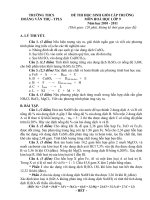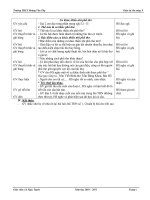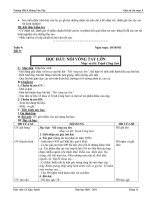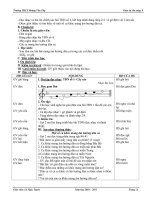- Trang chủ >>
- Khoa học tự nhiên >>
- Vật lý
trường thcs hoàng xuân hãn
Bạn đang xem bản rút gọn của tài liệu. Xem và tải ngay bản đầy đủ của tài liệu tại đây (228.2 KB, 6 trang )
<span class='text_page_counter'>(1)</span><div class='page_container' data-page=1>
20th Bay Area Mathematical Olympiad
BAMO 2018 Problems and Solutions
February 27, 2018
The problems from BAMO-8 are A–E, and the problems from BAMO-12 are 1–5.
A Twenty-five people of different heights stand in a 5⇥5 grid of squares, with one person in each square. We know
that each row has a shortest person; suppose Ana is the tallest of these five people. Similarly, we know that each
column has a tallest person; suppose Bev is the shortest of these five people.
Assuming Ana and Bev are not the same person, who is taller: Ana or Bev? Prove that your answer is always
correct.
Solution.Bev is taller. We consider three possible cases.
Case 1: If Ana and Bev are in the same row, then Bev is taller because Ana is by definition the shortest in that
row.
Case 2: If Ana and Bev are in the same column, then Bev is taller because Bev is by definition the tallest in that
column.
Case 3: If Ana and Bev are in neither the same row nor the same column, then let “Casey” be the person at the
intersection of Ana’s row and Bev’s column. Then Ana is shorter than Casey, and Casey is shorter than Bev, so
Ana is shorter than Bev.
B A square with sides of length 1 cm is given. There are many different ways to cut the square into four rectangles.
LetSbe the sum of the four rectangles’ perimeters. Describe all possible values ofSwith justification.
Solution.The answer is 6<S10. This can be shown by considering several cases, as shown in the 14 figures
below.
Square 1 Square 2 Square 3 Square 4
Square 8 Square 9 Square 10 Square 11
Square 5
10
10
8!2<i>x</i>
8!2<i>x</i>
8!2<i>x</i>
8!2<i>x</i>
<i>x</i>
<i>x</i>
<i>x</i>
<i>x</i>
6!4<i>x</i>
<i>x</i>
<i>x</i>
<i>x</i> <i>x</i>
6!4<i>x</i>
6!2<i>x+</i>2<i>y</i>
<i>x</i>
<i>y</i>
Square 7
Square 14
8
8
Square 6
Square 13
8
1"<i>x</i>
<i>x</i>
1"<i>x</i>
<i>x</i>
8
Square 12
6!2<i>x+</i>2<i>y</i>
<i>x</i> <i><sub>y</sub></i>
Observe that in every case, there is either a horizontal or a vertical line segment of length 1 drawn inside the
square, as well as some additional segments. For example, there are three suchverticallines inside Square 1, two
inside each of Squares 2-3, and one inside each of Squares 4-7. The figures in the first row are rotated by 90
to give corresponding partitions of the square in the second row, each with ahorizontalline cutting through the
whole square; except for Square 14, which displays two lines, a horizontal and a vertical one, that pass through
the center of the square.
</div>
<span class='text_page_counter'>(2)</span><div class='page_container' data-page=2>
more) rectangles that include them in their perimeters. So we must haveS=4+2·1+2a=6+2a, where 2·1
stands for twice a segment that crosses all the way through the square andastands for any additional segment(s)
inside the square. Sincea>0 in all cases, we haveS>6.
The maximum ofS=10 is achieved by cutting the square into four 1⇥1<sub>4</sub> rectangles with three parallel cuts, as
in Squares 1 and 8.
All values in between can be achieved as well. Indeed, the total perimetersS are written on top of each of the
14 cases. By shifting left or right the length 1 vertical segments in Squares 2,3,4, or by shifting up or down the
length 1 horizontal segments in Squares 9,10,11, we can make the lengthxvary from 0 to 1: 0<x<1. Thus,
for example, Square 4 can achieve any total perimeterS=6+4x between 6 and 10: 6<S<10. In a similar
way, Squares 5 and 12 can be drawn with lengthsxandyvarying between 0 and 1, and so these squares can also
achieve any perimeterS=6+2x+2ybetween 6 and 10.
Putting everything together,Scan be any number in the interval(6,10]; i.e. 6<S10. ⇤
C/1 An integercissquare-friendlyif it has the following property: For every integerm, the numberm2<sub>+</sub><sub>18</sub><sub>m</sub><sub>+</sub><sub>c</sub><sub>is</sub>
a perfect square. (A perfect square is a number of the formn2<sub>, where</sub><sub>n</sub><sub>is an integer. For example, 49</sub><sub>=</sub><sub>7</sub>2<sub>is a</sub>
perfect square while 46 is not a perfect square. Further, as an example, 6 is not square-friendly because form=2,
we have(2)2<sub>+ (18)(2) +</sub><sub>6</sub><sub>=</sub><sub>46, and 46 is not a perfect square.)</sub>
In fact, exactly one square-friendly integer exists. Show that this is the case by doing the following:
(a) Find a square-friendly integer, and prove that it is square-friendly.
(b) Prove that there cannot be two different square-friendly integers.
Solution.
(a) c=81 is square-friendly, sincem2+18m+81= (m+9)2which is an integer whenevermis an integer.
(b) Suppose there are two different square-friendly integerscandc0<sub>. In that case, for every integer</sub><sub>m</sub><sub>, we have</sub>
thatm2<sub>+</sub><sub>18</sub><sub>m</sub><sub>+</sub><sub>c</sub> <sub>and</sub><sub>m</sub>2<sub>+</sub><sub>18</sub><sub>m</sub><sub>+</sub><sub>c</sub>0 <sub>are perfect squares. Thus we have infinitely many pairs of perfect</sub>
squares that differ by c c0<sub>. However, this is not possible, because the differences between consecutive</sub>
squares are 1,3,5,7,9,11, . . .. Eventually these differences are greater than c c0, so no perfect square
beyond that point differs from another perfect square byc c0<sub>. Thus we have a contradiction, and so there</sub>
cannot be two different square-friendly integers.
D/2 Let pointsP1,P2,P3, andP4be arranged around a circle in that order. (One possible example is drawn in Diagram
1.) Next draw a line throughP4 parallel toP1P2, intersecting the circle again atP5. (If the line happens to be
tangent to the circle, we simply takeP5=P4, as in Diagram 2. In other words, we consider the second intersection
to be the point of tangency again.) Repeat this process twice more, drawing a line throughP5 parallel toP2P3,
intersecting the circle again atP6, and finally drawing a line throughP6 parallel toP3P4, intersecting the circle
again atP7. Prove thatP7is the same point asP1.
P1 P<sub>2</sub>
P3
P4
P1
P2
P3
P5 =P4
</div>
<span class='text_page_counter'>(3)</span><div class='page_container' data-page=3>
Solution. We claim that arcs P1P4 andP2P5 are congruent. This follows at once from the fact that these arcs
are intercepted by angles\P1P5P4 and\P5P1P2, which are congruent because they are alternate interior angles
to parallel segmentsP1P2 andP4P5. Furthermore, note that these two arcs are oppositely oriented; thus in the
diagramP4is situated in a clockwise direction away from P1 whileP5 is counterclockwise away fromP2. p In
the same manner, arcsP3P6andP4P7are also congruent toP1P4, oriented in the same and opposite ways toP1P4,
respectively. In summary, arcsP1P4andP4P7are congruent and oppositely oriented, which implies that pointsP1
andP7coincide.
Bonus Solution.This student-written solution won the BAMO Brilliance Award.
We use complex numbers. Let|a|,adenote the magnitude and complex conjugate ofa, respectively.
Without loss of generality,P1,P2,P3,P4are on the unit circle. LetP1=a,P2=b, . . . ,P7=gas complex numbers.
Note that|a|=<sub>|</sub>b<sub>|</sub>=<sub>|</sub>c<sub>|</sub>=<sub>|</sub>d<sub>|</sub>=<sub>|</sub>e<sub>|</sub>=<sub>|</sub>f<sub>|</sub>=<sub>|</sub>g<sub>|</sub>=1 =<sub>)</sub> a=1
a,b=
1
b,c=
1
c,d=
1
d,e=
1
e, f=
1
f,g=
1
g. Then
P4P5kP1P2 =) d e<sub>a b</sub>= d e
a b
=<sub>)</sub> d e
a b=
1
d 1e
1
a 1b
=<sub>)</sub> d e
a b=
✓
e d
b a
◆✓
ab
de
◆
=) ab<sub>de</sub> =1
=) e=ab
d .
In an analogous way,P5P6kP2P3 =) f= bc
e andP6P7kP3P4 =) g=
cd
f .
Then
P7=g=cd<sub>f</sub> = cd<sub>bc</sub>
e
=cde
bc =
de
b =
d ab
d
b =
ab
b =a=P1,
and we are done.
E/3 Suppose that 2002 numbers, each equal to 1 or 1, are written around a circle. For every two adjacent numbers,
their product is taken; it turns out that the sum of all 2002 such products is negative. Prove that the sum of the
original numbers has absolute value less than or equal to 1000. (The absolute value ofxis usually denoted by|x|.
It is equal toxifx 0, and to xifx<0. For example,|6|=6,|0|=0, and| 7|=7.)
Solution.Suppose thatnof the original numbers are+1, so that the remaining 2002 nare 1, and their sum is
1·n+ ( 1)·(2002 n) =2n 2002.
Also suppose thatmof the products equal 1; then the remaining 2002 mequal 1, and the sum of the products
is
</div>
<span class='text_page_counter'>(4)</span><div class='page_container' data-page=4>
Since this is negative,m>1001. Now, each product of 1 must come from a+1 and a 1 among the original
numbers, and each 1 among the original numbers can contribute to at most two such products; hence the original
numbers include more than 1001/2>500 1’s. Thus,
2002 n 501)n1501)2n 20021000.
Similarly, the original numbers include more than 500+1’s, so
n 501)2n 2002 1000.
Thus, 10002n 20021000, which is what we need.
4 (a) Find two quadruples of positive integers(a,b,c,n), each with a different value ofngreater than 3, such that
a
b+
b
c+
c
a =n.
(b) Show that ifa,b,c are nonzero integers such that a
b+
b
c+
c
a is an integer, thenabcis a perfect cube. (A
perfect cube is a number of the formn3<sub>, where</sub><sub>n</sub><sub>is an integer.)</sub>
Solution.
(a) For example,(1,2,4,5)and(9,2,12,6)work.
(b) Before solving the problem, we establish a useful definition and lemma.
Ifpis a prime andxis a nonzero rational number, we define ordpxto be the unique integerksuch thatp kx
is an integer not divisible byp. For example, ord345=2 and ord511<sub>5</sub> = 1. Then we claim the following:
Lemma.Letpbe prime and letx,ybe nonzero rational numbers. Then:
(i) ordp(xy) =ordpx+ordpy.
(ii) ordp(x/y) =ordpx ordpy.
(iii) If ordpx<ordpy, then ordp(x+y) =ordpx.
Proof of the lemma. Parts (i)–(ii) are straightforward. For part (iii), letk=ordpxandk+`=ordpy, where
we assume`>0. Then p kx=nand p k `y=mfor some integersm,nnot divisible by p. It follows that
p k<sub>(</sub><sub>x</sub><sub>+</sub><sub>y</sub><sub>) =</sub><sub>n</sub><sub>+</sub><sub>p</sub>`<sub>m</sub><sub>, and this is an integer not divisible by</sub><sub>p</sub><sub>. Thus ord</sub>
p(x+y) =kas claimed, proving the
lemma.⇤
Now we turn to the problem.
Supposea,b,care integers such thata/b+b/c+c/ais an integer. We will show that ordp(abc)is a multiple
of 3 for all primesp, which implies thatabcis a perfect cube.
Letpbe a prime and letr=ordpa,s=ordpb,t=ordpc. By part (i) of the lemma, ordp(abc) =r+s+t.
By part (ii) of the lemma, we have ordp(a/b) =r s, ordp(b/c) =s t, and ordp(c/a) =t r. If these three
differences are 0, thenr=s=tandr+s+tis trivially a multiple of 3. Otherwise, the least ofr s,s t,
t ris negative and the greatest is positive (since their sum is 0).
We now claim that at least two ofr s,s t,t rmust be tied for least. If this is not true, then, by applying
part (iii) of the lemma, we may conclude that ordp(a/b+b/c+c/a) =min{r s,s t,t r}<0, which
contradicts the assumption thata/b+b/c+c/ais an integer. Thus we have proven our claim. But if two of
r s,s t,t rare equal, thenr,s,t(in some order) form an arithmetic progression, andr+s+t is three
times the middle term of the progression. Thus we have shown that r+s+t is a multiple of 3; in other
words, ordp(abc)is a multiple of 3 for all primesp, and we are finished.
</div>
<span class='text_page_counter'>(5)</span><div class='page_container' data-page=5>
Aninteger-ratio right triangleis a right triangle whose side lengths are in an integer ratio. For example, a triangle
with sides 3,4,5 is an integer-ratio right triangle, and so is a triangle with sides 5<sub>2</sub>p3,6p3,13<sub>2</sub>p3. On the other
hand, the right triangle with sidesp2,p5,p7 is not an integer-ratio right triangle.
Determine, with proof, all integersnfor which it is possible to completely dissect a regularn-sided polygon into
integer-ratio right triangles.
Solution.Abbreviate integer-ratio right triangle by IRRT.
The square (n=4) has such a decomposition. For example, a 12<sub>⇥</sub>12 square can be cut into twenty-four 3–4–5
triangles as shown below:
Now we show thatn=4 is the only solution. The proof is by contradiction. Suppose ann-gon withn6=4 (and
n 3) has a dissection into IRRTs. Choose an arbitrary vertexPof then-gon. One or more IRRTs meet atP; let
their internal angles atPbeq1,q2, . . . ,qk, where we have
q1+q2+···+qk=n 2
n ·p. (1)
Observe that sinqi and cosqi are rational for eachi=1, . . . ,k. By applying angle-sum identities, we may infer
that the sine and cosine of n 2
n ·p, and thus of 2p/n, are rational as well. Applying angle-sum identities again, it
follows that for any divisormofn, the sine and cosine of 2p/mare also rational. Sincen6=4 andn 3,nhas a
divisor which is either 8 or an odd prime. So, we can restrict our attention to these two cases.
Forn=8, we have sin(2p/8) =p2/2. This is irrational, so we have our contradiction.
Now we consider the casen=pwhere pis an odd prime. Lett=tan(2p/p), which must be rational. By the
multiple-angle identity for tangents,tsatisfies
pt
✓<sub>p</sub>
3
◆
t3<sub>+</sub>✓p
5
◆
</div>
<span class='text_page_counter'>(6)</span><div class='page_container' data-page=6>
By the Rational Root Theorem, the only possible rational values oftaret=±1 andt=±p. Butt6=±1, because
2p
p 6=p4,3p4 ,5p4,7p4 . Ift=±p, then the left-hand side of (2) is congruent top2 (mod p3)and thus cannot equal 0.
Again, we have a contradiction.
</div>
<!--links-->









